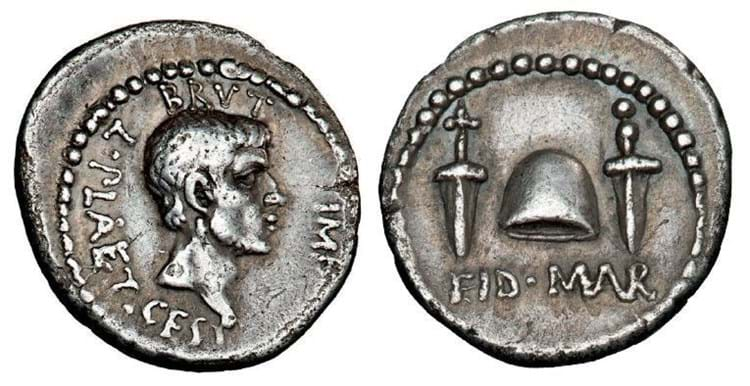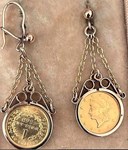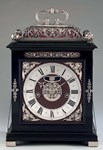
Two views of the Brutus Eid Mar-type silver denarius that took Dkr3.4m (£374,000) at Bruun Rasmussen on June 15.
Estimated at Dkr3m-4m, it took Dkr3.4m (£374,000) plus 25% buyer’s premium at Bruun Rasmussen (part of the Bonhams network) on June 15.
The coin, made by a military mint travelling with Brutus and Cassius in northern Greece during the late summer or autumn of 42BC, has long fascinated both numismatists and historians.
The simple reverse design contains the three principal elements used to kill a dictator: the pileus or cap of liberty and two daggers of differing design, one symbolising that wielded by Brutus himself on March 15, 44BC, the other that of Cassius, his co-conspirator. The legend Eid Mar abbreviates Eidibus Martiis - the Ides of March.
The inclusion of a portrait on the coin was an equally bold move. It was Caesar who, as dictator perpetuo, had been granted the honour of striking coins bearing his own likeness, thus breaking the ancient taboo of placing the face of a living Roman on a coin.
Created as a propaganda tool to spread the news of Brutus’ deed throughout the Empire, the coin is one of only a few mentioned in ancient sources. The Roman historian Lucius Cassius Dio wrote: “Brutus stamped, upon the Denarii which were being minted, his own likeness and a cap and two daggers indicating by this and by the inscription that he and Cassius had liberated the fatherland.”
80 surviving silver denarii
This is one of around 80 surviving silver denarii and considered ‘a superior example with an excellent portrait and an illustrious pedigree’. It came for sale from the published Apollo to Apollo collection with a history dating back to the 1930s and the Romanian numismatist Mina Paucker. It was sold as part of her collection in Paris in 1959.
The Eid Mar coin was also struck as a gold aureus. Only three of these are known: the coins in the British Museum and the Deutsche Bundesbank collection plus a controversial coin sold for £2.7m in London by Roma Numismatics in October 2020.
The validity of that Roma record has since been questioned after the coin was seized in January this year as part of an investigation into Richard Beale, the owner and managing director of Roma.
It has been alleged that the coin’s provenance to a 19th century Swiss aristocratic collection was fabricated (see ATG No 2585).














